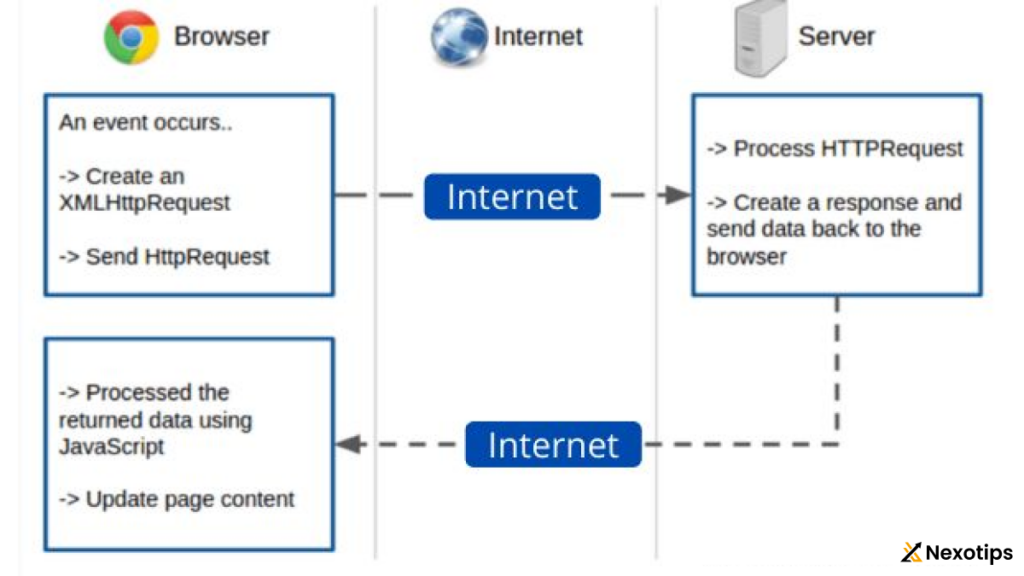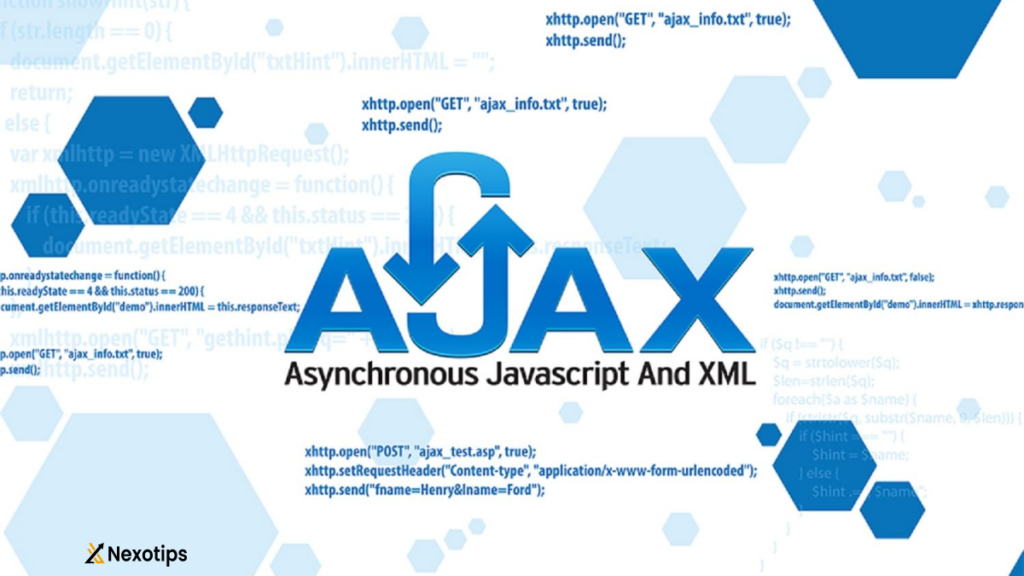
JavaScript AJAX Revolution: Empowering Dynamic Web Experiences for 2024
Contents :
In the realm of web development,JavaScript AJAX (Asynchronous JavaScript and XML) stands out as a transformative technology. It enables the creation of fast, dynamic, and highly interactive web applications by allowing the exchange of data with a server behind the scenes. This means that web pages can be updated asynchronously by exchanging small amounts of data with the server without having to reload the entire page. This blog post delves deeply into the world of JavaScript AJAX, exploring its fundamentals, advantages, practical applications, and advanced techniques, providing you with a comprehensive understanding of this essential web development tool.
What is JavaScript AJAX?
JavaScript AJAX is not a single technology but a suite of technologies used together to create asynchronous web applications. It combines:
- HTML: Used for structuring web content.
- CSS: Used for styling the content.
- JavaScript: The programming language used to manipulate the web page dynamically.
- XMLHttpRequest: The API used to create asynchronous requests to the server.
- XML/JSON: Data formats used for server responses. JSON (JavaScript Object Notation) is more popular due to its lightweight nature and ease of use with JavaScript.
Why Use JavaScript AJAX?
The primary motivation for using AJAX is to create a smoother and more responsive user experience. Here are some key benefits:
- Enhanced User Experience: AJAX allows parts of a web page to update without a full page reload, providing a seamless and fluid experience for users.
- Improved Performance: By only requesting the necessary data and updating only parts of the page, AJAX reduces the load on the server and the client, leading to faster interactions.
- Reduced Bandwidth Usage: Since only the required data is transferred, rather than reloading the entire page, bandwidth usage is significantly reduced.
- Increased Interactivity: AJAX enables more dynamic and interactive user interfaces, similar to desktop applications.
How Does JavaScript AJAX Work?
AJAX operates by using JavaScript to send and receive data asynchronously from a server. Here’s a step-by-step overview of the JavaScript AJAX process:
- Event Occurrence: A user action such as clicking a button triggers an AJAX request.
- Creating XMLHttpRequest Object: JavaScript creates an
XMLHttpRequestobject. - Configuring the Request: The request is configured using the
openmethod. - Sending the Request: The request is sent to the server using the
sendmethod. - Handling the Response: The server processes the request and sends back a response, which JavaScript handles by updating the DOM.

Basic AJAX Example
Here’s a simple example to illustrate how AJAX works:
htmlCopy code<!DOCTYPE html>
<html>
<head>
<title>AJAX Example</title>
</head>
<body>
<button id="loadDataBtn">Load Data</button>
<div id="dataContainer"></div>
<script>
document.getElementById('loadDataBtn').addEventListener('click', function() {
var xhr = new XMLHttpRequest();
xhr.open('GET', 'data.json', true);
xhr.onload = function() {
if (xhr.status == 200) {
var data = JSON.parse(xhr.responseText);
document.getElementById('dataContainer').innerHTML = 'Data: ' + data.message;
} else {
console.error('Error fetching data: ' + xhr.status);
}
};
xhr.send();
});
</script>
</body>
</html>
In this example, clicking the button triggers an AJAX request to fetch data from data.json. Upon receiving a successful response, the data is parsed and displayed in the dataContainer div.
Advanced AJAX Techniques
Handling Different Data Formats
While XML was the original format used in JavaScript AJAX, JSON has become the preferred format due to its simplicity. Here’s how to handle different data formats:
Handling JSON:
javascriptCopy codexhr.onload = function() {
if (xhr.status == 200) {
var data = JSON.parse(xhr.responseText);
console.log(data);
}
};
Handling XML:
javascriptCopy codexhr.onload = function() {
if (xhr.status == 200) {
var parser = new DOMParser();
var xmlDoc = parser.parseFromString(xhr.responseText, "text/xml");
console.log(xmlDoc);
}
};
Error Handling
Effective error management is essential for ensuring a seamless user interface. Here’s how you can manage errors in AJAX requests:
javascriptCopy codexhr.onerror = function() {
console.error('Request failed.');
};
xhr.onload = function() {
if (xhr.status == 200) {
var data = JSON.parse(xhr.responseText);
console.log(data);
} else {
console.error('Error fetching data: ' + xhr.status);
}
};
Asynchronous vs. Synchronous Requests
AJAX requests are asynchronous by default, meaning the script continues to run while waiting for the server’s response. However, you can make synchronous requests by setting the third parameter of the open method to false:
javascriptCopy codexhr.open('GET', 'data.json', false); // Synchronous request
Note: Synchronous requests are generally discouraged because they block the execution of other scripts and can make the web application unresponsive.
Modern Alternatives to XMLHttpRequest
While XMLHttpRequest is widely used, modern JavaScript offers more powerful methods like the Fetch API and libraries such as Axios.
Fetch API
The Fetch API provides a simpler, cleaner interface for making AJAX requests. Here’s an example:
javascriptCopy codefetch('data.json')
.then(response => {
if (!response.ok) {
throw new Error('Network response was not ok ' + response.statusText);
}
return response.json();
})
.then(data => {
console.log(data);
})
.catch(error => {
console.error('There was a problem with your fetch operation:', error);
});
Axios
Axios is a widely-used JavaScript library designed for facilitating HTTP requests. It is promise-based and works both in the browser and Node.js environments:
javascriptCopy codeaxios.get('data.json')
.then(response => {
console.log(response.data);
})
.catch(error => {
console.error('Error fetching data:', error);
});
Best Practices for Using JavaScript AJAX
To maximize the benefits of AJAX, follow these best practices:
- Optimize Server Performance: Ensure your server can handle the increased load from AJAX requests.
- Minimize Data Transfer: Only request the necessary data to reduce load times and improve performance.
- Secure Your Requests: Use HTTPS to secure data in transit. Validate and sanitize inputs on the server to prevent security vulnerabilities.
- Graceful Degradation: Ensure your application works even if JavaScript is disabled by providing fallbacks.
- Handle Errors Gracefully: Provide informative error messages and fallback actions in case of failures.

Real-World Applications of JavaScript AJAX
AJAX is used extensively in many real-world applications. Here are a few examples:
- Social Media Feeds: Platforms like Facebook and Twitter use AJAX to load new posts without refreshing the page.
- Autocomplete: Search engines like Google use AJAX to provide instant search suggestions.
- Live Chat Applications: Messaging platforms like WhatsApp Web use AJAX to send and receive messages in real time.
- Dynamic Forms: Web applications use AJAX to dynamically load form fields based on user input.
- Data Visualization: Platforms like Google Analytics use AJAX to fetch and update data visualizations in real time.
Conclusion
JavaScript AJAX is a powerful tool for creating fast, responsive, and dynamic web applications. By understanding the fundamentals of AJAX and implementing best practices, you can significantly enhance the user experience of your web applications. Whether using traditional XMLHttpRequest, the modern Fetch API, or libraries like Axios, mastering AJAX will empower you to build applications that are more interactive and engaging.
Read Also : JS HTML DOM Best Practices Every Web Developer Should Know For 2024
